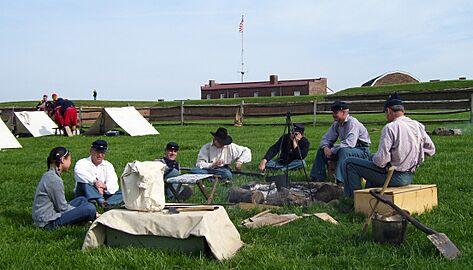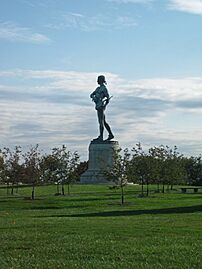Fort McHenry facts for kids
Quick facts for kids Fort McHenry National Monumentand Historic Shrine |
|
|---|---|
 |
|
| Location | 2400 East Fort Avenue Baltimore, Maryland, U.S. |
| Area | 43.26 acres (17.51 ha) |
| Visitors | 635,736 (in 2018) |
| Governing body | National Park Service |
| Designated | August 11, 1939 |
| Designated | October 15, 1966 |
|
Invalid designation
|
|
| Designated | 1986 |
Fort McHenry is a famous five-sided fort located in Baltimore, Maryland. It sits on Locust Point, guarding the entrance to Baltimore Harbor. This fort is most famous for its important role in the War of 1812. It successfully defended Baltimore from a British navy attack on September 13–14, 1814.
The fort was built in 1798. It was used by the U.S. armed forces through World War I and by the United States Coast Guard in World War II. In 1925, it became a national park. Then, in 1939, it was named a U.S. National Monument.
During the War of 1812, a smaller American flag flew over Fort McHenry during the British attack. This flag was about 17 by 25 feet. On the morning of September 14, 1814, a much larger American flag, about 30 by 42 feet, was raised. This big flag showed that the Americans had won the Battle of Baltimore.
Seeing this flag inspired a lawyer named Francis Scott Key. He wrote a poem called "Defence of Fort M'Henry." This poem later became the words to "The Star-Spangled Banner," which is now the national anthem of the United States.
Contents
History of Fort McHenry
Building the Fort in the 1700s
Fort McHenry was built where an older fort, Fort Whetstone, used to be. Fort Whetstone protected Baltimore from 1776 to 1797. The new fort was designed by a Frenchman named Jean Foncin in 1798. It was built between 1798 and 1800.
The main goal of the new fort was to better protect the important Port of Baltimore. The fort was shaped like a five-sided star. It had a deep, dry ditch around it, called a moat. This moat helped protect the fort from attacks by soldiers on land.
Fort McHenry was named after James McHenry. He was an immigrant from Scotland and Ireland who was a doctor and a soldier. He helped write the United States Constitution. He also served as the leader in charge of the army from 1796 to 1800.
The War of 1812 Battle
On September 13, 1814, British warships began attacking Fort McHenry. The attack lasted for 25 hours. The American defenders had cannons that fired heavy cannonballs. The British ships fired their cannons and rockets from about two miles away.
The British ships could not get past Fort McHenry. The Americans had blocked the harbor with a chain of sunken ships. The British weapons were not very accurate from that distance. This meant little damage was done to either side. The British stopped their attack on September 14 because they ran out of ammunition.
The Americans, led by Major George Armistead, had four people killed and 24 wounded. One bomb even crashed into the fort's gunpowder storage area. Luckily, it did not explode. The British navy's attempt to invade Baltimore had failed.
The Star-Spangled Banner Story

A lawyer named Francis Scott Key was in Baltimore during the attack. He was there to help release a prisoner. He watched the battle from a nearby ship. A very large American flag had been made by Mary Pickersgill for the fort.
When the sun rose on September 14, Key saw the huge flag still flying. He was so moved that he started writing a poem. This poem, "Defence of Fort M'Henry," was later set to music. It became "The Star-Spangled Banner," the national anthem of the United States.
Fort McHenry During the Civil War
During the American Civil War, Fort McHenry was used as a military prison. It held soldiers from the Confederate side. It also held some Maryland leaders who disagreed with President Abraham Lincoln.
Some of these leaders included Baltimore's mayor and police chief. Even Francis Scott Key's grandson was held there. You can still visit some of the old prison cells at the fort today. The fort also trained artillery soldiers during this time.
The 20th Century and Beyond
World War I and II Roles
During World War I, many extra buildings were put up around the fort. It became a large U.S. Army hospital for soldiers returning from Europe. These buildings are gone now, but the original fort has been restored to look like it did during the War of 1812.
In World War II, Fort McHenry became a Coast Guard base. It was used for training, but the historic parts of the fort stayed open to visitors.
Becoming a National Monument
The fort became a national park in 1925. On August 11, 1939, it was given a special title: "National Monument and Historic Shrine." It is the only place in the U.S. with both these titles. It was added to the National Register of Historic Places in 1966.
It's a tradition that when a new U.S. flag design is made, it first flies over Fort McHenry. The first official 49-star and 50-star American flags flew here.
Fort McHenry Today
Today, Fort McHenry is a popular spot for both locals and tourists. Thousands of people visit each year to see where the Star-Spangled Banner was born. You can easily get there by water taxi from Baltimore's Inner Harbor.
Archaeologists have found artifacts at the fort. These items are on display in the buildings around the Parade Ground and in the Visitor Center. These exhibits show how the fort has been used over many years.
Every September, Baltimore celebrates Defenders Day. This event honors the Battle of Baltimore. It's the biggest celebration at the fort, with special programs, events, and fireworks.
In 2013, Fort McHenry was honored with its own quarter coin. This was part of the America the Beautiful Quarters Program.
In 2014, Fort McHenry celebrated the 200th anniversary of the Star-Spangled Banner. This event, called the Star-Spangled Spectacular, included tall ships, fireworks, and the Navy's Blue Angels.
Restoration work began around 2015 to preserve the original bricks of the fort. This mainly involved replacing the mortar between the bricks.
In 2020, Vice President Mike Pence gave a speech at Fort McHenry. This happened during the COVID-19 pandemic, when the Republican National Convention could not be held as usual.
Images for kids
See also
 In Spanish: Fuerte McHenry para niños
In Spanish: Fuerte McHenry para niños
- List of forts
- Fort McHenry Tunnel – a tunnel that passes near the fort, part of Interstate 95
- List of national monuments of the United States








